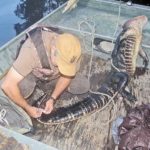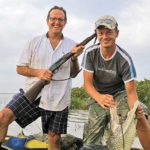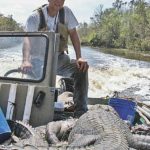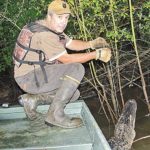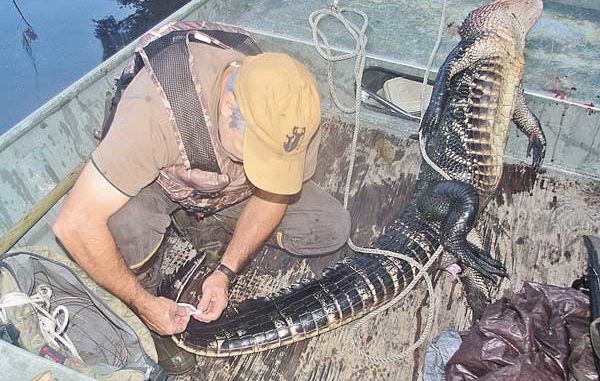
There are so many gators on several WMAs that the state has opened hunting to Average Joes. Here’s how to get in on the fun.
For most hunters, the traditional fall and winter hunting season begins the first Saturday in September when dove season opens. The first couple of weekends in September are buzzing with hunting activity as hunters sharpen up their shooting skills on these gray ghosts. Now, thanks to a new program initiated by the Louisiana Department of Wildlife and Fisheries in 2008, alligator hunting can be the new first season.
Most of the alligator hunting in the state is done by commercial trappers in the marshes. In the past, the gator harvest on the wildlife management areas was also regulated through a program utilizing commercial trappers. Last summer, LDWF initiated a program on nine WMAs that would issue an alligator hunting license and three alligator tags to individuals selected by a lottery drawing. Last summer, 90 slots were available for this special hunting program.
Alligator hunting could best be described as alligator fishing. It is somewhat like setting a limb line for catfish or snapping turtles, except the bait is hung out of the water. The normal procedure is to go out at night and locate alligators using a Q-beam light. Alligator eyes give off an orange glow when shined, and the size of the alligator can be estimated by judging the distance from the eyes to the snout. In general, 1 inch is equal to 1 foot of gator, so an estimate of 4 inches between the eyes and snout would equate to a 4-foot alligator.
Most hunters try to target the larger alligators to get a better price, so those that are 6 feet or longer are the ones sought after. At the time of the season, the females are hanging around the nests and, therefore, are generally not caught by hunters.
After locating alligators, the hunter will hang a line with a hook baited with chicken or beef smelt. Most trappers use the tarred 120 nylon twine and a big-game fish hook. The length of the line can vary, but enough is needed to ensure the gator swallows the hook; if the gator is hooked in the mouth, there is a good chance it will get off.
Alligators will extend their bodies up out of the water to grab the bait, so the higher the bait is above the water line (at least 16 inches), the better the chances are for catching a larger alligator. Alligators are active at night, so the lines are set during daylight hours; hunters are not allowed to harvest gators at night.
The hunter’s heart begins pounding when he sees that the line is in the water and the water is stirring. The hunter generally has a helper who will pull the line while the hunter prepares to shoot the gator. Only the licensed hunter may legally kill the alligator. The gator is pulled up to the boat with its head out of the water, and the hunter shoots it on top of the skull; a .22 rifle is enough firepower to dispatch the gator.
Once the beast is in the boat, the hunter immediately places the tag on the gator. After all the lines are checked, the hunter heads to the dock, loads the gator into the truck and heads out to the alligator buyer.
Today, most alligators are sold whole; very few trappers skin their own alligators. In 1979, when the season re-opened in the state following removal of the alligator from the endangered-species list, most hunters skinned their alligators at their camps. The market for the meat had not been developed, but it wasn’t long before it was. Alligator meat is now on the menu at most restaurants, and is an accepted food item for the family dinner table.
Hunters selected to participate in these special WMA lottery alligator hunts must agree to give LDWF 40 percent of the money received from the sale of the alligator (hide and meat). If the hunter wants to keep the hides and have some leather products made, he still must give LDWF its 40 percent share for each alligator. Hunters must also adhere to other rules and regulations pertaining to the possession of alligator hides.
There are other rules and regulations for alligator hunters selected to hunt on WMAs. A hunter is allowed to set only two lines for each alligator tag issued (maximum of six lines). This is done in order to keep from possibly catching more than three alligators. Since a hunter would have to release an alligator once the hunter has used his three tags, the regulation would help reduce the chances for an overharvest and the risk of turning a gator loose that might die.
All lines must be marked with flagging and tagged with the hunter’s name and license number. The regular WMA commercial hunters were allowed to begin harvesting gators a week before this special season began.
According to Jonathan Wiebe with the LDWF Alligator Program, there were plenty of applicants for the coastal WMAs. However, the two hurricanes that hit the state last year had an impact on participation and the harvest.
Since I was familiar with Pearl River WMA, I applied only for that area. Applicants may apply for any or all of the WMAs, but may only be selected for one area. With the high gas prices last summer, I figured Pearl River was about as far as I wanted to travel.
There were also plenty of applicants for the other WMAs, and I felt fortunate to have been selected for Pearl. All selected hunters had to attend an orientation session conducted by the WMA regional staff where they learned the rules and regulations, purchased their licenses and were issued their tags.
The hunting aspect of alligator hunting occurs during the scouting period. I drove over to Pearl River a few days before the commercial season opened, and searched the sloughs and bayous off the East Pearl River. The marsh habitat below Highway 90 no doubt is the best alligator habitat on the area, but I figured since I had only three tags, there were enough alligators in the area I was searching. Sure enough, I found several alligators in the 6- to 8-foot range, and found one that was at least 10 feet, maybe a little better. My plan was to come back in a week when our season opened and concentrate on the larger ones.
Unfortunately, Hurricane Gustav plowed through the state and hit Baton Rouge really hard, so my gator hunt was put on hold while I ran a generator for 11 days and made trips to Mississippi for gas. Finally, conditions improved, the power was restored, tree limbs and other debris piled up on the street and the boat and gator fishing gear made ready for the weekend of the 12th.
However, Hurricane Ike began to make its way across the coast, and once again my hunt was in jeopardy. But it appeared that perhaps the hurricane had moved out in the Gulf enough for me to go, so I left Baton Rouge and headed east. As I crossed the big East Pearl River Bridge on I-10, I realized that I may be in trouble due to the flooding. Sure enough, I could not get close enough to the boat ramp to launch, and I could not launch off the gravel road, so I loaded the pirogue with gear and paddled off.
The water current was strong in the river, but I was able to set three lines at locations I had seen alligators a few weeks earlier.
The next morning, I found that the water level had dropped, and lines that were a 16 inches above the water were now several feet above the water. I readjusted the lines and set a couple of lines on the West Pearl near Crawford Landing, but the results were the same. The flooding must have moved the gators around, and they were just not interested in feeding.
This weekend had turned out to be just a waste of time and gas money, plus my boat motor was beginning to give me some trouble.
By the following week, water levels had returned to normal, and with the season set to end on the 25th, I made plans for my second attempt. I had not heard that the season had been extended due to the hurricanes.
I set six lines on the East Pearl system, and stayed around after dark to investigate some new areas in case my gators had totally vacated their old haunts. I found a nice gator that looked to be about 8 feet that I felt certain I could catch if I was unsuccessful with the other lines.
My Friday morning line check netted a nice 6-foot gator at a location where I had seen two in the 6-foot range. I drew a blank with the other lines.
I left the two lines near the location where I had seen the nice 10-footer, moved one line to a site where I saw one that was 6 to 8 feet long, and put the other line at my new location. I drove back to Crawford Landing, unhitched the boat and drove to Independence to sell the gator.
The buyer documented the length and tag number on the Alligator Buyer-Dealer Records Form, and I advised him I wanted to buy back the meat and the head.
I returned to Crawford and searched the West Pearl River, and was pleased to see a 6- to 8-footer sunning on the bank near the mouth of a small slough.
The Saturday morning run resulted in the harvest of the alligator at the new location, and it turned out to be 7½ feet long.
With only two lines left that I could legally set, I picked up the other lines off the East Pearl, and headed back to Crawford and then to Independence to sell this alligator. My first alligator was a female, but this one was a male.
I returned to Crawford, and set my two lines, one at the location where I had seen the gator on the bank and the other downriver below the interstate.
Sure enough, the gator that I had seen was on the first line the next morning, and my season was over when I put the tag on this 7-foot male gator. I sold it, and completed my paperwork to file with LDWF. Once I received the check from the buyer, I wrote a check to LDWF for 40 percent of the total amount received for the three alligators, and sent my check and other records to the regional office.
I have to admit that the cost of my alligator hunting adventure was more than what I received for the sale of the alligators. Buying back the meat and heads was around $85, the lottery application fee and license was $30, fishing supplies and bait around $50, gas from Baton Rouge to Slidell and to Independence was $150+, my check to LDWF was about $250 and the repair for electrical motor problems was close to $1,000; but the overall experience was priceless.
We have enjoyed the alligator meat, and I have been able to share it with family and friends. Hopefully my two grandsons will enjoy the alligator head plaque. Needless to say, I will certainly apply again.
There is one thing potential applicants need to be aware of. According to Noel Kinler, who is the biologist in charge of the LDWF Alligator Program, the alligator market is suppressed at this time, and there is no market for hides in the 4- to 6-foot category. The price for larger wild alligator skins may be around $15 a foot, which is about half of what it was last year.
